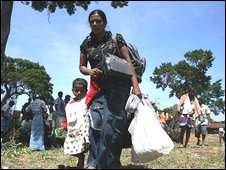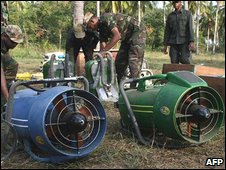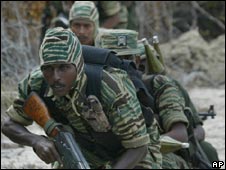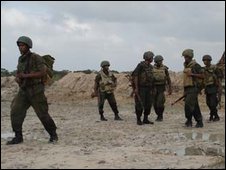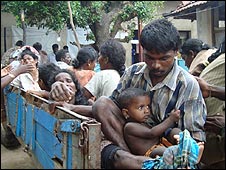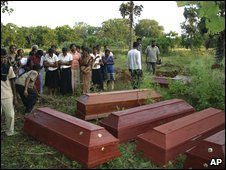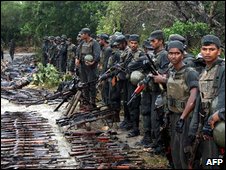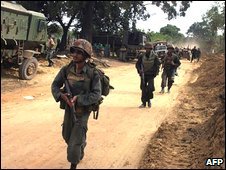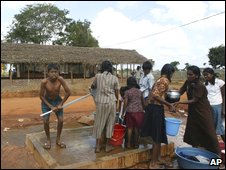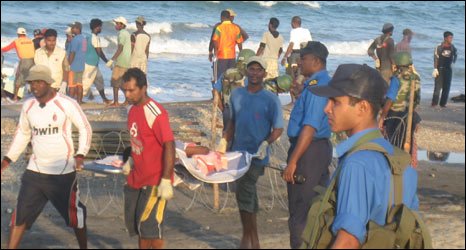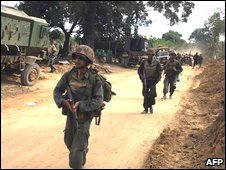Sri Lanka civilians tell of war ordeal, BBC News, Monday, 6 April 2009
Civilians on a Red Cross-supervised ship are disembarked for treatment
Civilians fleeing the area in north-east Sri Lanka where Tamil Tiger rebels and government forces
are in fierce conflict have been telling the BBC of the ordeal of life under almost constant gunfire.
Added to the intense shelling there is an acute shortage of water, food and medicine.
The civilians also confirmed the long-levelled accusations by human rights groups that the Tigers
are forcefully recruiting young children and are stopping people from moving out to
government-controlled areas. Some of the injured civilians from Wanni have been brought to
Pulmoddai hospital in Trincomalee district on a ship under the supervision of the Red Cross.
After receiving initial treatment in a medical facility manned by a medical team from India,
patients are sent to various hospitals in the north for further treatment.
Child recruitment
The BBC Tamil service secured rare access to some of the civilians who had arrived at Pulmoddai
hospital, accompanying injured relatives. Sridharan is one of more than 800 civilians who have
arrived in the past few days on the ship. He is hoping to get medical treatment for his three-year-old
son Vidushan. "My wife was killed last Friday in a shell attack. My son was injured. He has an injury
in his back. Living conditions are getting very bad there. We had nothing to eat for the last five days.
Prices are going up every day," he said. A doctor at Pulmoddai hospital said some patients had lost
limbs and most had shellfire injuries.
The area designated by the Sri Lankan government as a "safe zone" is about 20 sq km of coastal
land in Mullaitivu district. The government on Sunday said the Tigers no longer controlled any area
beyond this. Estimates of the number of civilians trapped in the area vary from 50,000 to 200,000.
The Sri Lankan government and other international organisations have repeatedly urged the rebels
to free civilians in the conflict zone. The Tamil Tigers say the people are choosing to stay.
Independent journalists are not allowed to go to the war zone.
The Tigers have continuously denied accusations of recruiting children. But the recent batch of
patients who reached Pulmoddai say rebels are showing no mercy and are taking away as many
people as possible from families.
One civilian, Kauruppaiah Ganapathipillai, said: "The Tigers are increasing the recruitment of children.
Now one cannot even send the children out to fetch water. "They are even taking 14-year-old kids.
In some cases which I know they have taken four to five people from the same family. There is
continuous shelling. Scores are dying every day." Sources from a local hospital say hundreds of
civilians die every week due to shell attacks.
The Tigers have accused the army of regular and indiscriminate shelling of civilians but the military
denies this.
The UN and aid agencies have accused the government of not taking enough measures to protect
civilians caught in the conflict zone.
Head injury
Moving to government-controlled areas is not an easy option for trapped civilians.
One woman who fled, Pakkiyavathi, said: "People take great risks to escape. They have to walk
for days braving shelling. If [Tamil Tiger] cadres spot them they will fire at them. "A few days ago
more than 200 people tried to cross over to the government-controlled areas on their own. [Tamil
Tiger] cadres fired at them, one was killed." The civilians also say that most of the houses and shops
have been destroyed and it seems that there are only a few wells to meet drinking water needs.
One civilian, Shanmugaraja, says his wife was hit by a shell five days ago and sustained a serious
head injury. He says by coming to Pulmoddai hospital her chances of survival have improved.
"A piece of pellet is still inside her head. It is very difficult to live there. We had nothing to eat. In
the [Tamil Tiger] controlled area there is no electricity and a big shortage of water. You have to wait
in long queues to get water. People think [the Tigers] are losing but many don't feel sad about this,"
he said.
There remains no guarantee that life will change for the better once the civilians cross to government-
controlled areas. One mother, paralysed from the waist down, told her story to an NGO supported
by Christian Aid after she reached a government camp. "My husband was pushing me on a bicycle,
searching for safe areas. In the worst of the fighting we lost the bicycle - I was in a bad situation.
Ultimately we all had to scatter and the family was separated.
"Somehow we were able to get out of the war zone and reach a safer place. We were then locked
up in a fenced area, isolated from the people outside. But we were alive." She added: "We are
prevented from freely meeting with visitors. Even if we can make contact with family outside,
all we can do is talk to them through the wire fence. "The people are suffering under these rigid
restrictions. Wives, husbands, children, friends are kept apart and cannot share their painful
feelings or support each other."
The Sri Lankan government has promised to improve the conditions in the camps. Due to the
intense fighting over the past few months a number of families have been displaced many times,
some more than a dozen. Most of them have lost everything they had.
One elderly lady, Kanagasabapathi Rasamma, broke down while narrating her journey. "We have
come from Pudumathalan hospital. There is fighting everywhere, bombing and deaths… Oh God
how much we have suffered… What we did to endure this… Nobody is there to save us. No-one
is helping us," she said.

